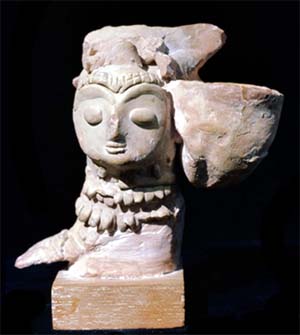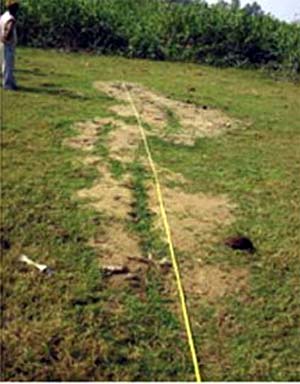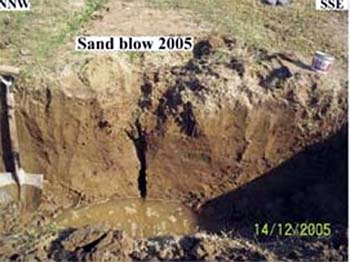Dec 30, 2025
Dec 30, 2025
 The Indus Valley civilization which prospered along the Indus and its tributaries, some 5000 years ago for about 3000 years, suddenly vanished. What must have happened some 2000 years ago that made the people flee/perish is a matter of debate. One thing is almost certain that there must have been an environmental catastrophe like an earthquake that must have taken its toll. Today only the remnants of old civilization in the form of ruins, seals, etc are found.
The Indus Valley civilization which prospered along the Indus and its tributaries, some 5000 years ago for about 3000 years, suddenly vanished. What must have happened some 2000 years ago that made the people flee/perish is a matter of debate. One thing is almost certain that there must have been an environmental catastrophe like an earthquake that must have taken its toll. Today only the remnants of old civilization in the form of ruins, seals, etc are found.
What happened to the people living in those houses?
A great earthquake on 8 October 2005 in Muzaffarabad-Kashmir region of the intensity 7.6 killed more than 80,000 people and rendered many more homeless. The ruins of their houses resembled almost the ruins of the Indus Valley. Well that is drawing too much of a conjecture, but the possibility can not be ruled out, if we go by the recent finds of R. Jayangondaperumah, V.C. Thakur and N. Suresh of Wadia Institute of Himalayan Geology (WIHG), Dehradun. The lead author is presently working at Centre for Geotechnology, MS University, Tiruneveli, India.
The epicenter of the event was located north of Muzaffarabad, about 120 km west North West of Srinagar, within the Hazara Syntaxis (i.e. the plane along which the Himalayas make an inverted V turn from Northwest to Northeast) say the authors. They suggest that the earthquake was caused by movement along multiple fault planes.
 Often in case of earthquakes the sand is liquefied and mobilized. Imagine the sand in the sub-surface like toothpaste in its tube. One end of the tube is pressed and the paste comes out. Similarly during an earthquake the liquefied sand comes out on the surface in the form of sand blows and fissures. These features are tell-tale marks left by the earlier events of major earthquake events. The science of tell-tale marks of earthquakes or paleo-seismology is comparatively a recent addition to the study of devastating earthquakes that occurred more than 500 years ago (Read When the Earth Trembles).
Often in case of earthquakes the sand is liquefied and mobilized. Imagine the sand in the sub-surface like toothpaste in its tube. One end of the tube is pressed and the paste comes out. Similarly during an earthquake the liquefied sand comes out on the surface in the form of sand blows and fissures. These features are tell-tale marks left by the earlier events of major earthquake events. The science of tell-tale marks of earthquakes or paleo-seismology is comparatively a recent addition to the study of devastating earthquakes that occurred more than 500 years ago (Read When the Earth Trembles).
Jammu & Kashmir being close to Hazara syntaxis is a region which is stressed in the sub-surface. The continuous movement of the Indian Plate under the stationery Tibetan Plate is the cause of the stress. A release of such sub-terranean stresses causes tremors. This region had had its share of earthquakes in the past too.
Abu Fazal describes in his Akbar Nama a devastating earthquake that hit the region in September 1555. Yet another earthquake event hit the region in AD 1885. Some researchers have assigned them a magnitude of MW 7.5 and 6.3 respectively. While describing earthquake magnitude, the seismologists try to work out the seismic moment or the direction of tilt of fault and the direction the rock moved. It is abbreviated aw MW. This method gives a truer picture of the magnitude of the earthquake. In addition to these two major earthquakes, J&K has been rocked in AD 1123 and AD 1501 in the past. Details of their epicenter etc are not known hence broadly grouped as Kashmir Earthquakes say the researchers.
 With this background information about the area Jayangondaperumah and his team like a Sherlock Holmes minutely scanned the affected ground and soon they found what they were searching. They were looking for the 'Tell Tale' marks of the past earthquakes. Around 20 km southwest of Jammu at the foot of the Simbal Camp ridge fresh white sand was found oozed out from the subsurface and deposited on the green grass. Local villagers were the first to notice the fountain of sand and water gushing out from the ground during the October 2005 earthquake that shook Muzaffarabad and J&K. Soon the WIHG team located another four such sand blows within a 250 m long and 110 m wide area. Everywhere the white sand had gushed out on the green grass. These fields on which the sand blows had occurred are the abandoned flood plains of Balawal River.
With this background information about the area Jayangondaperumah and his team like a Sherlock Holmes minutely scanned the affected ground and soon they found what they were searching. They were looking for the 'Tell Tale' marks of the past earthquakes. Around 20 km southwest of Jammu at the foot of the Simbal Camp ridge fresh white sand was found oozed out from the subsurface and deposited on the green grass. Local villagers were the first to notice the fountain of sand and water gushing out from the ground during the October 2005 earthquake that shook Muzaffarabad and J&K. Soon the WIHG team located another four such sand blows within a 250 m long and 110 m wide area. Everywhere the white sand had gushed out on the green grass. These fields on which the sand blows had occurred are the abandoned flood plains of Balawal River.
Rivers from the Himalayas, carrying their load of boulders, sand and silt, lose their energy suddenly on entering the plains. This makes them dump their load. It fans out in the form of an inverted cone while the river carries on. When many such fans are there in close proximity they coalesce and form ridges. Such ridges are called as Piedmont ridges. Simbal camp is the remnant one of the piedmont ridges about 18 m higher than the flood plain of the river.
For the seismologists on trail of ancient 'Tell Tale' marks this setting was an ideal location. Trenches were dug across the sand blows and fissures at Simbal Camp and the findings from the sub-surface were quite interesting.
Evidences of two past earthquake events, prior to 2005 earthquake were found in the form of liquefied sand injections in the sub-surface. The lower liquefied layer gave an age of 2003-133 years BP, called as event II by these researchers. The host sediments of the Simbal Camp ridge had given two ages. The sediments at the base of the scarp gave an age of 9596-1047 years BP and those of the top gave an age of 1003-132 years BP. The sand layer of event I is younger than 2003-133 years BP and older than the top host sediments of 1003'132 years BP. In simpler terms the first earthquake of a high magnitude took place at the beginning of the English calendar and the second event in the opinion of Jayangondaperumah et al 'perhaps coincided with the AD 1123 earthquake of Kashmir valley!
This find is significant as it indicates a recurrence interval of 1000 years for major earthquakes in the area. The trend of the faults surveyed in this area shows that transmission stress is towards southeast. That is why the liquefaction took place as far as 240 km from the epicenter of the earthquake. Such features were also found after the January 2001 Bhuj earthquake at a distance of 250 km from the epicenter.
The sub-surface transmission of stresses could prove disastrous for the mega-hydro-electrical projects on the surface. Earlier studies by Geological Survey Of India (GSI) in Riasi area had shown neo-active deformation structures in the area of Salal Hydro-electric project. The authors now confirm that fault at Riasi is an active fault. The active faults, like earthquakes are unpredictable. Their proper identification is a must. Once established they need to be monitored continuously to avoid any risk to life and property.
Areas like Hazara Syntaxis need detailed seismic evaluation to avoid destruction of life as happened in case of Muzaffarabad earthquake. The science of seismology is making rapid strides, but awareness about earthquakes in India is not up to the mark-more concentrated efforts on part of media are required to keep people informed about the geo-hazard.
11-Jan-2009
More by : V. K. Joshi (Bijji)

|
Thanks JK for your wonderful illuminating comments. Wish I had discussed with you before doing this story! While posted in Jammu, I had also noticed several evidences of neotectonism, in Riasi, and also around Ramnagar. But those days these things didnt interest me... |

|
Thanx Joshi Sahib for an illuminating article on Quakes with reference to J&K and Jammu-Reasi area. In course of Geoenvironmental Studies of Jammu district in nineties, we observed evidences of neotectonic activity in a clay quarry walls in Jammu suburban site. In fact this activity is prevalent all along foothills. Preservation of evidences, however, is scanty and need close study. Braiding of the mighty Chenab R. just downstream Akhnoor is a significant evidence in this regard pointing to major tectonic movements. Most interesting feature observed was a series of Archaeological mounds/sites discovered by ASI along one of the braided channels of Chenab on its left flank. ASI located seven layers of habitation in the excavations which we too examined and photographed, before they were filled up. The last building effort was placed at 1800 AD. So till recent times there have been efforts to inhabitate the fertile plains along braided channels of Chenab on account of abundant water resource availability. Embankment techniques were obviously lacking in the ancient times which are available now to contain mighty rivers like Chenab. Their habitations were getting inundated again and again and finally they were so scared that they inhabited an upland dry place like Old Jammu city located on Boulder Conglomerate. They dug up tanks for water storage and preferred to use smaller river Tawi waters, though they had to trek a lot for that. This is the reason that Jammu is where it is, 30 Km off Chenab and it developed into a big habitation. Akhnoor, on the right bank of Chenab remained a smal town only. |

|
Thank you Lujack. I could not understand your comments. Could you please elaborate? In the past natural calamities, invasions, famines all affected the human societies-as they do so even now. But anyway thanks you for the information about the history. |

|
The Mohenjo-Daro Dravidan civilization fell to the invading Indo-Aryans in 1700 B.C. during the global famine. (Genesis 41:57) The famine lasted 7 years 1704-1697 B.C. (1) The Hebrew Jacob entered Egypt in the famine's second year in 1702 B.C. (2) Hyksos/Canaanite chieftain Sheshi arrived in Egypt in 1702 B.C. (3) Minoans from Crete immigrated to mainland Greece spreading their culture there beginning 1700 B.C. Minoan merchants also traded with Egypt. (4) Babylonian Amorite king Abi-Eshuh 1710-1684 B.C. the Indo-European Sealanders invaded lower Babylonia and he damned up the Tigris river during the global famine to starve them out. (5) Indo-European Celts entered western China introducing the Chinese to the horse driven chariot in 1700 B.C. Chinese archaeologist found their mummies there. Note: The first horse driven chariot mentioned in history is when the Indo-European Kassites attacked Amorite king Samsu-iluna 1749-1711 B.C. in 1741 B.C. in their horse driven chariots. Note: Joseph was given the second Egyptian chariot (Genesis 41:43) when an Egyptian king (Senusret III yes he had horses for a horse skeleton was found under the ramparts at the fortress at Buhen, Nubia which was built by Senusret III by archaeologist in 1959 A.D.) Genesis 41:39-the king was Egyptian who appointed Joseph as an Egyptian governor when Joseph was 30 years old in 1711 B.C. (6) The Shang Dynasty had a seven year famine verifying Joseph's 7 year famine. (7) Olmecs entered in the Yucatan Peninsula inventing plumbing and were interested in water conservation in 1700 B.C. (8) Agricultural Americans Indians established the Poverty Point Mound Culture in Louisianna in 1700 B.C. establishing their first society at this stressful time in world history. |

|
Thank you Tare Balram Laxman. Well you are right, but this could be one of the reasons how the civilisations vanished. One thing is certain, that the past civilisations vanished due to natural calamities and taking a cue from that, we have to treat the Nature with utmost care. We lag in that direction... |

|
Thank you and also grateful to you. Will our history teachers take pains to expllain how the Indus civilisation vanished. |

|
Thank you Santosh. |

|
Read d article n enriched my knowledge about earthquake & it's nw aspect. |